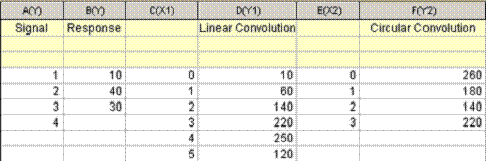
Analysis: Signal Processing: Convolution
Compute convolution of two signals
1. conv ix:= Col(1) response:= Col(2);
2. conv ix:= Col(1) response:= Col(2) n:=1;
3. conv ix:=Col(1) response:=Col(2) wrap:=1;
4. conv ix:=Col(1) response:=Col(2) circular:=circular;
5. conv ix:=Col(1) response:=Col(2) norm:=0 wrap:=0 circular:=circular oy:=[Book2]1!(col(1),col(2));
Please refer to the page for additional option switches when accessing the x-function from script
| Display Name |
Variable Name |
I/O and Type |
Default Value |
Description |
|---|---|---|---|---|
| Signal | ix |
Input vector |
|
Specifies the signal. |
| Response | response |
Input vector |
|
Specifies the response. |
| Sampling Interval | interval |
Input double |
|
Specifies the sampling interval. The default is <auto>, which corresponds to an automatically-computed interval. |
| Normalize Response | norm |
Input int |
|
Specifies whether the response should be normalized |
| Wrap Response | wrap |
Input int |
|
Specifies whether the response should be wrapped |
| Convolution Type | circular |
Input int |
|
Specifies whether the convolution is linear or circular Option list
|
| Output | oy |
Output XYRange |
|
Specifies the output range. See the syntax here. |
1. To perform a linear convolution with the signal in Column 1 and the response in Column 2 of the active worksheet, use the script command:
conv ix:=col(1) response:=col(2)
2. To perform a circular convolution with the signal in Column 1 and the response in Column 2 of the active worksheet, use the script command:
conv ix:=col(1) response:=col(2) circular:=1


For more informatioin, please refer to our User Guide.
Keywords:convolute, linear, circular, wrap